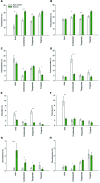Response of Soil Properties and Microbial Communities to Agriculture: Implications for Primary Productivity and Soil Health Indicators
- PMID: 27462326
- PMCID: PMC4940416
- DOI: 10.3389/fpls.2016.00990
Response of Soil Properties and Microbial Communities to Agriculture: Implications for Primary Productivity and Soil Health Indicators
Abstract
Agricultural intensification is placing tremendous pressure on the soil's capacity to maintain its functions leading to large-scale ecosystem degradation and loss of productivity in the long term. Therefore, there is an urgent need to find early indicators of soil health degradation in response to agricultural management. In recent years, major advances in soil meta-genomic and spatial studies on microbial communities and community-level molecular characteristics can now be exploited as 'biomarker' indicators of ecosystem processes for monitoring and managing sustainable soil health under global change. However, a continental scale, cross biome approach assessing soil microbial communities and their functional potential to identify the unifying principles governing the susceptibility of soil biodiversity to land conversion is lacking. We conducted a meta-analysis from a dataset generated from 102 peer-reviewed publications as well as unpublished data to explore how properties directly linked to soil nutritional health (total C and N; C:N ratio), primary productivity (NPP) and microbial diversity and composition (relative abundance of major bacterial phyla determined by next generation sequencing techniques) are affected in response to agricultural management across the main biomes of Earth (arid, continental, temperate and tropical). In our analysis, we found strong statistical trends in the relative abundance of several bacterial phyla in agricultural (e.g., Actinobacteria and Chloroflexi) and natural (Acidobacteria, Proteobacteria, and Cyanobacteria) systems across all regions and these trends correlated well with many soil properties. However, main effects of agriculture on soil properties and productivity were biome-dependent. Our meta-analysis provides evidence on the predictable nature of the microbial community responses to vegetation type. This knowledge can be exploited in future for developing a new set of indicators for primary productivity and soil health.
Keywords: agriculture intensification; indicators; soil bacteria; soil health.
Figures





References
-
- Acosta-Martinez V., Burow G., Zobeck T. M., Allen V. G. (2010). Soil microbial communities and function in alternative systems to continuous cotton. Soil Sci. Soc. Am. J. 74 1181–1192. 10.2136/sssaj2008.0065 - DOI
-
- Acosta-Martinez V., Dowd S., Sun Y., Allen V. (2008). Tag-encoded pyrosequencing analysis of bacterial diversity in a single soil type as affected by management and land use. Soil Biol. Biochem. 40 2762–2770. 10.1016/j.soilbio.2008.07.022 - DOI
-
- Armstrong R. D., Eagle C., Flood R. (2015). Improving grain yields on a sodic clay soil in a temperate, medium-rainfall cropping environment. Crop Pasture Sci. 66 492–505. 10.1071/CP14210 - DOI
LinkOut - more resources
Full Text Sources
Other Literature Sources

